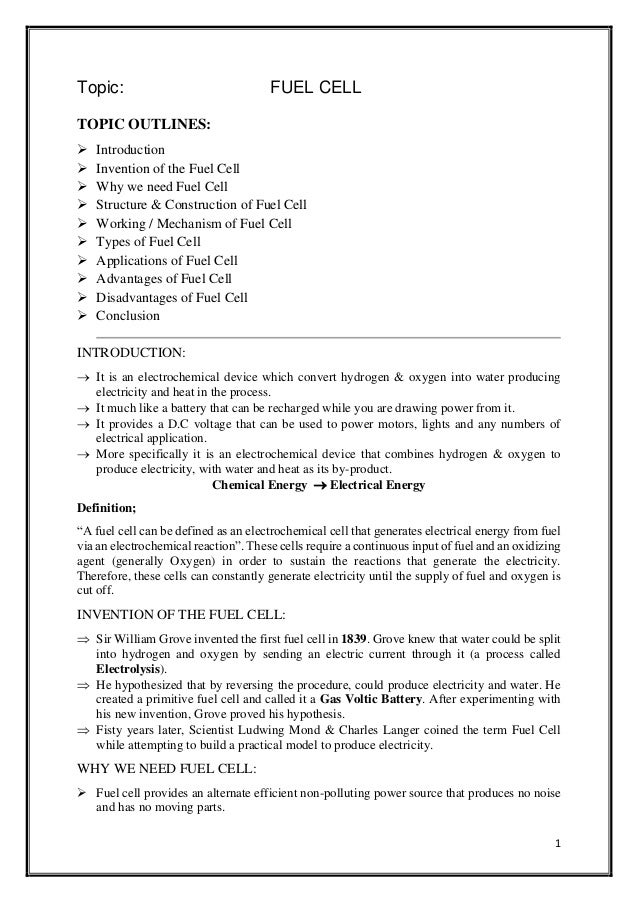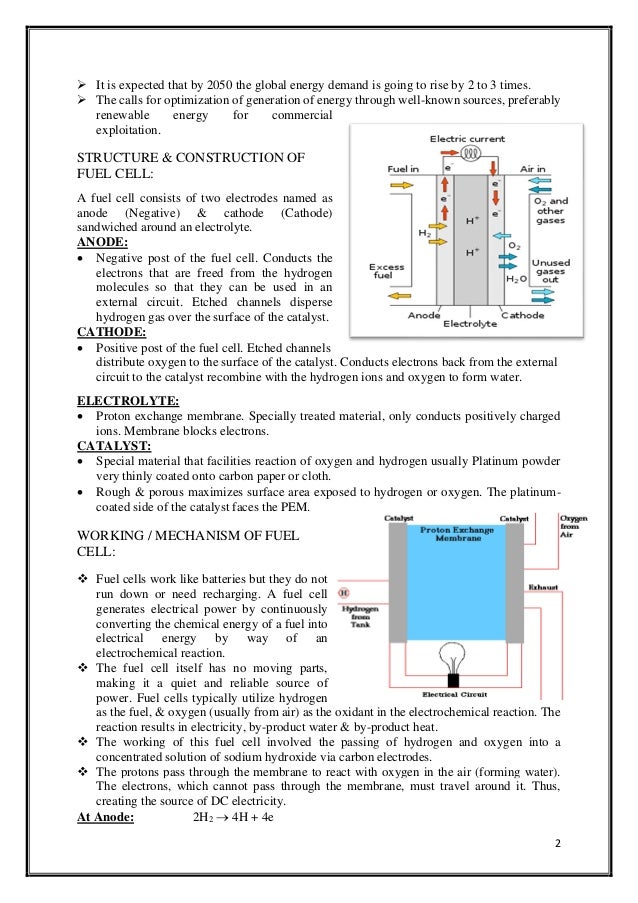Fuel Cell.pdf
- 1. 1 Topic: FUEL CELL TOPIC OUTLINES: âĒ Introduction âĒ Invention of the Fuel Cell âĒ Why we need Fuel Cell âĒ Structure & Construction of Fuel Cell âĒ Working / Mechanism of Fuel Cell âĒ Types of Fuel Cell âĒ Applications of Fuel Cell âĒ Advantages of Fuel Cell âĒ Disadvantages of Fuel Cell âĒ Conclusion INTRODUCTION: â It is an electrochemical device which convert hydrogen & oxygen into water producing electricity and heat in the process. â It much like a battery that can be recharged while you are drawing power from it. â It provides a D.C voltage that can be used to power motors, lights and any numbers of electrical application. â More specifically it is an electrochemical device that combines hydrogen & oxygen to produce electricity, with water and heat as its by-product. Chemical Energy â Electrical Energy Definition; âA fuel cell can be defined as an electrochemical cell that generates electrical energy from fuel via an electrochemical reactionâ. These cells require a continuous input of fuel and an oxidizing agent (generally Oxygen) in order to sustain the reactions that generate the electricity. Therefore, these cells can constantly generate electricity until the supply of fuel and oxygen is cut off. INVENTION OF THE FUEL CELL: ï Sir William Grove invented the first fuel cell in 1839. Grove knew that water could be split into hydrogen and oxygen by sending an electric current through it (a process called Electrolysis). ï He hypothesized that by reversing the procedure, could produce electricity and water. He created a primitive fuel cell and called it a Gas Voltic Battery. After experimenting with his new invention, Grove proved his hypothesis. ï Fisty years later, Scientist Ludwing Mond & Charles Langer coined the term Fuel Cell while attempting to build a practical model to produce electricity. WHY WE NEED FUEL CELL: âĒ Fuel cell provides an alternate efficient non-polluting power source that produces no noise and has no moving parts.
- 2. 2 âĒ It is expected that by 2050 the global energy demand is going to rise by 2 to 3 times. âĒ The calls for optimization of generation of energy through well-known sources, preferably renewable energy for commercial exploitation. STRUCTURE & CONSTRUCTION OF FUEL CELL: A fuel cell consists of two electrodes named as anode (Negative) & cathode (Cathode) sandwiched around an electrolyte. ANODE: âĒ Negative post of the fuel cell. Conducts the electrons that are freed from the hydrogen molecules so that they can be used in an external circuit. Etched channels disperse hydrogen gas over the surface of the catalyst. CATHODE: âĒ Positive post of the fuel cell. Etched channels distribute oxygen to the surface of the catalyst. Conducts electrons back from the external circuit to the catalyst recombine with the hydrogen ions and oxygen to form water. ELECTROLYTE: âĒ Proton exchange membrane. Specially treated material, only conducts positively charged ions. Membrane blocks electrons. CATALYST: âĒ Special material that facilities reaction of oxygen and hydrogen usually Platinum powder very thinly coated onto carbon paper or cloth. âĒ Rough & porous maximizes surface area exposed to hydrogen or oxygen. The platinum- coated side of the catalyst faces the PEM. WORKING / MECHANISM OF FUEL CELL: â Fuel cells work like batteries but they do not run down or need recharging. A fuel cell generates electrical power by continuously converting the chemical energy of a fuel into electrical energy by way of an electrochemical reaction. â The fuel cell itself has no moving parts, making it a quiet and reliable source of power. Fuel cells typically utilize hydrogen as the fuel, & oxygen (usually from air) as the oxidant in the electrochemical reaction. The reaction results in electricity, by-product water & by-product heat. â The working of this fuel cell involved the passing of hydrogen and oxygen into a concentrated solution of sodium hydroxide via carbon electrodes. â The protons pass through the membrane to react with oxygen in the air (forming water). The electrons, which cannot pass through the membrane, must travel around it. Thus, creating the source of DC electricity. At Anode: 2H2 â 4H + 4e
- 3. 3 At Cathode: O2 + 4H + 4e â 2H2O Net Reaction: 2H2 + O2 â 2H2O TYPES OF FUEL CELL: There exist many varieties of fuel cells. Some of these types of fuel cells are; A. The Polymer Electrolyte Membrane (PEM) Fuel Cell B. Phosphoric Acid Fuel Cell C. Solid Oxide Fuel Cell D. Alkaline Fuel Cell E. Molten Carbonate Fuel Cell A. The Polymer Electrolyte Membrane (PEM) Fuel Cell: o These cells are also known as proton exchange membrane fuel cells (or PEMFCs). o The temperature range that these cells operate in is between 50o C to 100o o The electrolyte used in PEMFCs is a polymer which has the ability to conduct protons. o A typical PEM fuel cell consists of bipolar plates, a catalyst, electrodes, and the polymer membrane. o Despite having eco-friendly applications in transportation, PEMFCs can also be used for the stationary and portable generation of power. It has, o Efficiency is about 40 to 50 percent, and operating temperature is about 80 degrees C (about 175 degrees F). B. Phosphoric Acid Fuel Cell: o Molten phosphoric acid is the electrolyte used in this type of fuel cell. It operates at high temperature up to 200 0 C. It has an efficiency of up to 55%. This type of fuel cell is most commonly used in commercial cars. It has; o Phosphoric acid electrolyte. o 40-80% efficiency. o 150 0 C â 200 0 C operating temperature. o 11 MW units have been tested. o Sulphur free gasoline can be used as a fuel. o The electrolyte is very corrosive. o Platinum catalyst is very expensive.
- 4. 4 C. Solid Oxide Fuel Cell: o This is one the most commercially used fuel cell as they have the highest operating life. It has a very high operating temperature of 1000 0 C. At high temp the device can produce water in the form of steam which can be easily transported through steam turbine to produce more electricity. Thus, increasing in the efficiency of the system. o These cells involve the use of a solid oxide or a ceramic electrolyte (such as yttria-stabilized zirconia). o These fuel cells are highly efficient and have a relatively low cost (theoretical efficiency can even approach 85%). o As the device has a very high operating temp, there are some disadvantages as well. There may be unwanted number of the reactions taking place inside the cell due the high temperature. D. Alkaline Fuel Cell: o This type of fuel cell was been introduced in the early 1960âs. As the electrolyte used for this device is aqueous alkaline solution like potassium hydroxide, the procedure for electricity consumption is rather expensive. o This was the fuel cell which was used as the primary source of electricity in the Apollo space program. o In these cells, an aqueous alkaline solution is used to saturate a porous matrix, which is in turn used to separate the electrodes. o The operating temperatures of these cells are quite low (approximately 90o C). o These cells are highly efficient. They also produce heat and water along with electricity. It has; o Compressed hydrogen & oxygen fuel. o Potassium hydroxide (KOH) electrolyte. o -70% efficiency. o 150 0 C â 200 0 C operating temp. o 300W to 5KW output requires pure hydrogen fuel and platinum catalyst.
- 5. 5 E. Molten Carbonate Fuel Cell: o The electrolyte used in these cells is lithium potassium carbonate salt. This salt becomes liquid at high temperatures, enabling the movement of carbonate ions. o Similar to SOFCs, these fuel cells also have a relatively high operating temperature of 650o o The anode and the cathode of this cell are vulnerable to corrosion due to the high operating temperature and the presence of the carbonate electrolyte. o These cells can be powered by carbon-based fuels such as natural gas and biogas. o It has an efficiency of almost 55%. APPLICATIONS OF FUEL CELL: Fuel cell technology has a wide range of applications. Currently, heavy research is being conducted in order to manufacture a cost-efficient automobile which is powered by a fuel cell. A few applications of this technology are listed below. ⊠Fuel cell electric vehicles, or FCEVs, use clean fuels and are therefore more eco-friendly than internal combustion engine-based vehicles.
- 6. 6 ⊠They have been used to power many space expeditions including the Apollo space program. ⊠Generally, the by products produced from these cells are heat and water. ⊠The portability of some fuel cells is extremely useful in some military applications. ⊠These electrochemical cells can also be used to power several electronic devices. ⊠Fuel cells are also used as primary or backup sources of electricity in many remote areas. ⊠Fuel cell are also used in waste water treatment plant & landfill. ⊠Telecommunication, MP3 players ⊠Fuel cells also make sense for portable power like laptop, computers and cellular phones. ⊠Fuel cells powered cars will start to replace gas and diesel engine cars in about 2055. Fuel cell powered buses are already running in several cities. ADVANTAGES OF FUEL CELL: Fuel cell have the following advantages; âĒ Water is the only discharge (Pure H2). âĒ Higher efficiency than conventional engines. âĒ Excellent part load characteristics and has zero emission. âĒ Long operating period between failures. âĒ No rotating parts in the main hard ware components and negligible noise pollution. DISADVANTAGES OF FUEL CELL: Following disadvantages of fuel cell are; âĒ CO2 discharged with methanol reform. âĒ Little more efficient than alternatives. âĒ Pure hydrogen is difficult to handle. âĒ Initial cost of installation is higher. Comparative cost of energy storage of fuel cells is around twice that of conventional source of energy. âĒ Energy produced by one fuel cell is around 0.7 volts. CONCLUSION: âĒ The commercial power units are technically feasible. âĒ Research & development should be aimed at reducing cost & increasing life. âĒ Future cities can be planned on fuel cell systems for their power & energy requirements. Best of Luck





